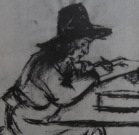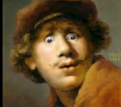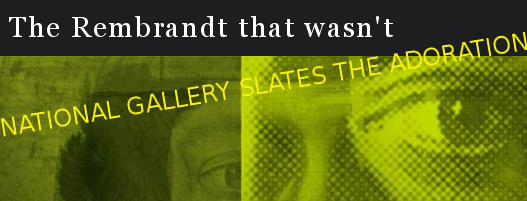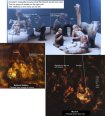| History of the Discovery |
|
I am a sculptor and when I was at art school I came to revere Rembrandt as the one old-master who seemed to speak to me (and many of my peers) directly. His drawings struck me as the greatest sculptural drawings ever made. I studied them and tried to analyse what it was that allowed him to make such utterly comprehensible statements about the human condition. His figures were not just full of life and movement but often he seemed to penetrate the inmost thoughts of his characters. With a few lines he was able to sum up what he saw; from the quality of the clothes his characters wore to the spirit which motivated their actions. He conveyed it all. I based my own endeavours on what I understood of Rembrandt. Since then my understanding has deepened very considerably, mainly as a result of a request – I was asked to give a talk on Rembrandt to students at the art school where I taught. I bought the two volume Dover paperback edition of Rembrandt's drawings to research what others thought of him. I was delighted by the drawings I found there but astonished by what I read about them. The scholars were dismissing drawings saying they were not Rembrandts. I had never seen these drawings before but some struck me as masterpieces (see the David drawing). I tried to find out what had caused this discrepancy. The drawings in the Dover edition had all been accepted as Rembrandt's in 1904 but more recent scholarship had found reason to dismiss many of them. One of the first questions that I asked myself was did Rembrandt draw his biblical and mythological subjects from life? I answered that question with a resounding YES. I realized subsequently, that the scholars believed the opposite: that the drawings were Rembrandt's inventions, drawn from imagination. This difference of view proved to be crucial to the interpretation of his works. To prove the presence of a group of live models I made a sculptural replica of the group of models around the bed in the David drawing. I believed that I would be able to walk round the bed and see the subject of other Rembrandt drawings. What I actually saw was the reverse of the subject. I returned to the position from which I had constructed the maquette (Rembrandt's viewpoint) and inserted a mirror, immediately I saw the subject matter of another Rembrandt drawing 'Isaac Blessing Jacob' in precise detail, in the mirror. See short film clip -[!! Be advised this clip is 5MB and will take about an hour to download on a dial-up connection and about 10 minutes on Broadband. - A more compressed version should be available soon.] There was an extraneous figure in the David drawing (Solomon's acolyte) which Rembrandt had started to draw in and then converted into a jug on a bedside table. I was enthralled. I made several such groups (The Dismissal of Hagar is illustrated in Mirrors). I can cite nearly one hundred examples of Rembrandt's use of mirrors in this way. I had stumbled upon Rembrandt's desire to maximize the possibilities of a single group of models. At the time I thought 'the scholars are not going to like this but they will be obliged to bow to the weight of factual evidence that I had accumulated'. I was right about the first; the resistance was solid but wrong about the second. Thirty-one years later it would be true to say that scholars have continued as before, dismissing hundreds of paintings and drawings that are Rembrandts. I love Rembrandt because his messages are conveyed in the everyday language of the body. Body-language can be read without special training by people of all cultures. It would be true to say that Rembrandt was the first and greatest artist to tap this universal way of conveying feeling. He discovered body-language and used its full potential. I love him for his simple directness. He uses marks that anyone can make, nothing over clever. He shows us what is essential and meaningful in life. I love his acceptance of failure as a valid outcome of a period of work. I love the roughness of his execution, his refusal to dazzle with virtuoso craftsmanship or to hide his clumsinesses. He dazzles us with his all-encompassing vision. He imagined the scenes of the Bible and recreated them in Holland with the common folk as his models. All is as true to his vision and straight forward as could be. He believed that art and life were intimately connected. Rembrandt's attitudes have influenced many generations of artists. VanGogh worshipped Rembrandt. Rembrandt is our signpost, our light, our supreme example. We need to save him to save our culture. He is our great teacher. |









